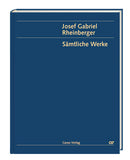| 作曲者 | Josef Rheinberger (1839-1901)・ヨーゼフ・ラインベルガ― |
| タイトル | Konzertouvertüren |
| 出版社 | Carus・カールス |
| シリーズ名 | Complete edition (Gesamtausgabe). Vol. 25 |
| 品番 | M007090739 |
| 校訂者 | Felix Loy |
| 形状 | 208 ページ・25 x 32 cm・1370 g・布装丁 |
| 出版年 | 2006年 |
| 出版番号 | CV 50.225/00 |
| ISMN | 979-0-007-09073-9 |
| ISBN | 9783899480245 |
| サンプル | https://www.carusmedia.com/images-intern/medien/50/5022500/5022500x.pdf |
Rheinberger's concert overtures are completely beholden to the tradition of the genre established at least since the 1820s. The spread of this genre was favored in equal measure by the growth of bourgeois musical culture and the overwhelming model of Beethoven's nine symphonies, which sowed a certain perplexity and discouragement among composers of the next generation and led them to turn increasingly to the smaller single-movement genre in their orchestral music. Soon a generic distinction arose between two types of overture. One was the autonomous overture, whose character results from its specific introductory function. Rheinberger's Academic Overture follows in this same line of tradition. The other type was the overture with subject-matter, in which the romantic inclination to recreate extra-musical material in music found an expecially fruitful field of exploration. Having originated as the opening item of an opera or play, the overture had, after all, long been accustomed to accommodating the contents of the work that followed. The concert overture on an extra-musical subject is in turn associated in particular with the works of Felix Mendelssohn Bartholdy. Rheinberger too, closely modeled his opp. 11 and 110 on Mendelssohn's overtures.



